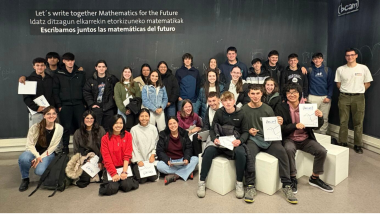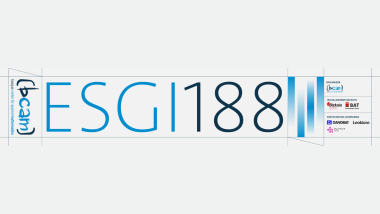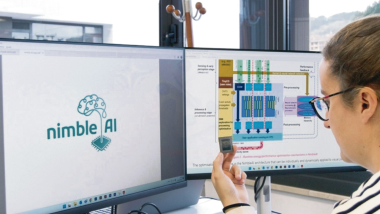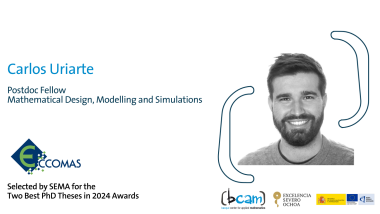Ezhilmathi Krishnasamy will defend his doctoral thesis on Thursday, July 16th
- Due to the restrictions caused by the COVID-19 pandemic, the defense will be held online and users will be able to follow it live
Ezhilmathi Krishnasamy obtained a Diploma (2003) and a Bachelor’s Degree (2007) in Chemical Technology from the Institute of Chemical Technology in Chennai (India) and Anna University (India), respectively. In 2012 he finished a Master’s in Energy and Environmental Engineering at Linköping University (Sweden) and in 2015 he completed a Specialization in Computational Science at the same university.
In late 2015, he joined the Basque Center for Applied Mathematics - BCAM as a PhD student (La Caixa 2014) within the CFD Computational Technology research line. During this period, he spent some time at the KTH Royal Institute of Technology in Stockholm (Sweden).
His PhD thesis, High Performance Scientific Computing in Applications with Direct Finite Element Simulation, has been directed by Johan Jansson.
Due to the COVID-19 pandemic, the defense will be held online, through the platform BBCollaborate. It will take place on Thursday, July 16th at 14:00, and users will be able to follow it live using this link: https://eu.bbcollab.com/collab/ui/session/guest/2a07b7b574e04e70b06ea01381a67ad3
On behalf of all BCAM members, we would like to wish Ezhilmathi the best of luck in his upcoming thesis defense.
PhD thesis title: High Performance Scientific Computing in Applications with Direct Finite Element Simulation
Abstract:
To predict separated flow including stall of a full aircraft with Computational Fluid Dynamics (CFD) is considered one of the problems of the grand challenges to be solved by 2030, according to NASA [1]. The nonlinear Navier- Stokes equations provide the mathematical formulation for fluid flow in 3- dimensional spaces. However, classical solutions, existence, and uniqueness are still missing. Since brute-force computation is intractable, to perform predictive simulation for a full aircraft, one can use Direct Numerical Simulation (DNS); however, it is prohibitively expensive as it needs to resolve the turbulent scales of order Re4. Considering other methods such as statistical average Reynolds’s Average Navier Stokes (RANS), spatial average Large Eddy Simulation (LES), and hybrid Detached Eddy Simulation (DES), which require less number of degrees of freedom. All of these methods have to be tuned to benchmark problems, and moreover, near the walls, the mesh has to be very fine to resolve boundary layers (which means the computational cost is very expensive). Above all, the results are sensitive to, e.g. explicit parameters in the method, the mesh, etc.
As a resolution to the challenge, here we present the adaptive time- resolved Direct FEM Solution (DFS) methodology with numerical tripping, as a predictive, parameter-free family of methods for turbulent flow. We solved the JAXA Standard Model (JSM) aircraft model at realistic Reynolds number, presented as part of the High Lift Prediction Workshop 3. We predicted lift Cl within 5% error vs. experiment, drag Cd within 10% error and stall 1◦ within the angle of attack. The workshop identified a likely experimental error of order 10% for the drag results. The simulation is 10 times faster and cheaper when compared to traditional or existing CFD approaches. The efficiency mainly comes from the slip boundary condition that allows coarse meshes near walls, goal-oriented adaptive error control that refines the mesh only where needed and large time steps using a Schur-type fixed-point iteration method, without compromising the accuracy of the simulation results.
As a follow-up, we were invited to the Fifth High Order CFD Workshop, where the approach was validated for a tandem sphere problem (low Reynolds number turbulent flow) wherein a second sphere is placed a certain distance downstream from a first sphere. The results capture the expected slipstream phenomenon, with appx. 2% error. A comparison with the higher-order frameworks Nek500 and PyFR was done. The PyFR framework has demonstrated high effectiveness for GPUs with an unstructured mesh, which is a hard problem in this field. This is achieved by an explicit time-stepping approach. Our study showed that our large time step approach enabled appx. 3 orders of magnitude larger time steps than the explicit time steps in PyFR, which made our method more effective for solving the whole problem.
We also presented a generalization of DFS to variable density and validated against the well-established MARIN benchmark problem. The results show good agreement with experimental results in the form of pressure sensors. Later, we used this methodology to solve two applications in multiphase flow problems. One has to do with a flash rainwater storage tank (Bilbao water consortium), and the second is about designing a nozzle for 3D printing.
In the flash rainwater storage tank, we predicted that the water height in the tank has a significant influence on how the flow behaves downstream of the tank door (valve). For the 3D printing, we developed an efficient design with the focused jet flow to prevent oxidation and heating at the tip of the nozzle during a melting process.
Finally, we presented here the parallelism on multiple GPUs and the embedded system Kalray architecture. Almost all supercomputers today have heterogeneous architectures, such as CPU+GPU or other accelerators, and it is, therefore, essential to develop computational frameworks to take advantage of them.
For multiple GPUs, we developed a stencil computation, applied to geological folds simulation. We explored halo computation and used CUDA streams to optimize computation and communication time. The resulting performance gain was 23% for four GPUs with Fermi architecture, and the corresponding improvement obtained on four Kepler GPUs were 47%.
The Kalray architecture is designed to have low energy consumption. Here we tested the Jacobi method with different communication strategies.
Additionally, visualization is a crucial area when we do scientific simulations. We developed an automated visualization framework, where we could see that task parallelization is more than 10 times faster than data parallelization. We have also used our DFS in the cloud computing setting to validate the simulation against the local cluster simulation. Finally, we recommend the easy pre-processing tool to support DFS simulation.
Related news
About the center
About the center




